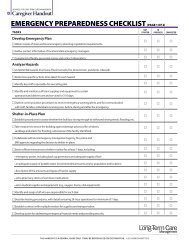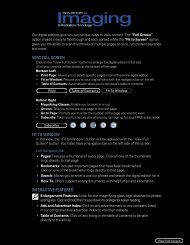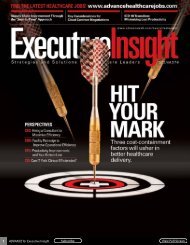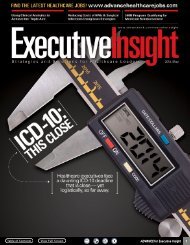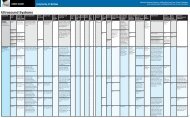ADVANCE for Executive Insight 1 ADVANCE for Executive Insight
ADVANCE for Executive Insight 1 ADVANCE for Executive Insight
ADVANCE for Executive Insight 1 ADVANCE for Executive Insight
- No tags were found...
You also want an ePaper? Increase the reach of your titles
YUMPU automatically turns print PDFs into web optimized ePapers that Google loves.
inventory management<br />
The more a consistent<br />
inventory<br />
process is<br />
maintained, the<br />
more efficient<br />
and cost-effective<br />
the departments<br />
within a facility<br />
become.<br />
On the Web<br />
For more inventory management<br />
solutions, enter<br />
“Inventory Management”<br />
in the keyword search<br />
box at www.advanceweb.<br />
com/executiveinsight<br />
as vital to avoiding additional expenses down the<br />
line. These committees should enlist representatives<br />
from the facility, including:<br />
n Clinical users, who work with the equipment<br />
daily and understand the needs of the facility<br />
n Clinical engineers, who are responsible <strong>for</strong> the<br />
maintenance of that equipment<br />
n Supply chain workers, who have to stop the<br />
consumables <strong>for</strong> that product<br />
n Financial supervisors, who have to budget <strong>for</strong><br />
that equipment<br />
n IT professionals, who are in charge of incorporating<br />
that equipment into the facility networks<br />
“People get too enthralled by bells and whistles<br />
and want the latest, greatest and the newest,”<br />
explained Skochdopole. “When, in reality, <strong>for</strong><br />
what they’re doing and how they’re reimbursed,<br />
they are not necessary.”<br />
Organizational Issues<br />
On the other side of the coin, a large problem<br />
that leads to cost creep is organizational policies<br />
within the facility. Skochdopole discussed<br />
what actions individual healthcare professionals<br />
can take to prevent potential sources of cost<br />
creep. Different machines and devices become<br />
underutilized due to mistakes in recordkeeping<br />
and inventory tracking. He pointed out that the<br />
average device in a healthcare setting, even the<br />
ones that seem scarce, are overstocked (i.e., average<br />
utilization is under 50%). Rather than over<br />
spending on extra resources, facilities can counter<br />
the additional funding that would otherwise<br />
go to waste by ensuring efficiency within their<br />
own inventory departments.<br />
“A big part of it is the clinical staff understanding<br />
where things are, when they’re available, central<br />
supply cleaning them, clinical engineering<br />
maintaining them,” said Skochdopole. “So, really<br />
it’s ‘have it available and ready when it’s time to<br />
use it so that you don’t have to overbuy and become<br />
inefficient.’”<br />
Donate Unused Equipment<br />
On top of disorganized inventory systems, hospitals<br />
and clinics put older or unused machines<br />
into storage rather than exploring other options;<br />
smaller or more rural hospitals lacking in upto-date<br />
equipment may welcome the addition<br />
of older technology. While this is great news<br />
<strong>for</strong> the hospital receiving the technology, this<br />
would also be ideal <strong>for</strong> the hospitals supplying<br />
used equipment that could then cut down on<br />
cost creep – as storing old equipment ends up<br />
running up bills in regards to warehouse fees and<br />
storage costs.<br />
As the healthcare industry continues to grow,<br />
it’s important <strong>for</strong> healthcare facilities and their<br />
respective staff to focus on factors that lead to<br />
excess spending over time within the organization<br />
and methods to limit cost creep. While new<br />
technologies are influencing trends in hospitals<br />
and clinics, inventory practices are becoming vital<br />
to maintaining financial standardization over<br />
time not only to adapt with the changing industry,<br />
but also to know when it’s time to phase out<br />
older equipment <strong>for</strong> newer technologies. The<br />
more a consistent inventory process is maintained,<br />
the more efficient and cost-effective the<br />
departments within a facility become – and, as<br />
the older equipment is donated to other, less<br />
prominent hospitals lacking funds <strong>for</strong> new technology,<br />
their programs can become more efficient<br />
as well.<br />
36 <strong>ADVANCE</strong> <strong>for</strong> <strong>Executive</strong> <strong>Insight</strong>



